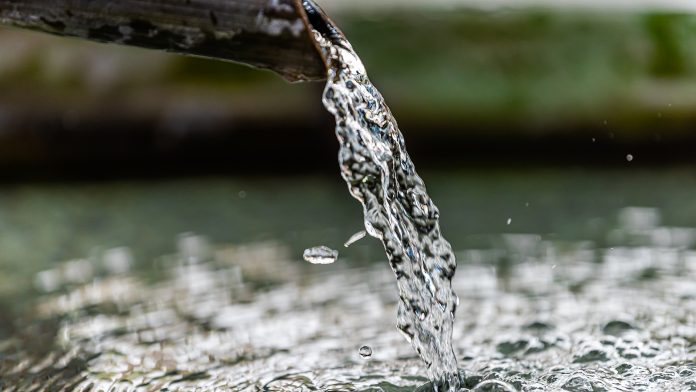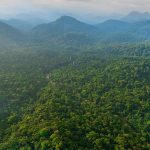The United Nations has recognized access to water as a basic human right, stating that water is a social and cultural good, not merely an economic commodity. Since ancient times, water has been recognized universally as an invaluable resource. Water has been harvested in India since the dawn of civilization. The Ramayana, Mahabharata and various other Vedic, Buddhist and Jain texts contain several references to water harvesting structures in existence and water being revered as a life giving and sustaining force. Water covers 70% -75% of earth’s surface of which 97.2% is locked in sea or oceans (1332 million cu.km, considering total availability as 1400 million cu km), 3% is fresh water 2.15% in polar ice caps (29.20 cu.km), < 1% available as surface and sub surface water (rivers, streams, lakes) with which we have to manage ourselves. Water is renewable resource. It may change it’s form but quantity of water on earth has remained same for millions of years. Out of 1400 million cu.km. of water available on earth, only 14 million cu.km. is fresh water. As per the National Commission on Agriculture, considering an average rainfall of 1200mm, the water wealth of India is about 400 million hectare meters.
Main sources of water for our use are:
Rainfall: India can be broadly divided into 15 ecological regions. The vast ecological diversity of this country is reflected in the diversity in available water
resources. With an average annual rainfall of 1170 mm, India is one of the wettest countries in the world. However, there are large variations in the seasonal and geographical distribution of rainfall over the country. At one extreme are areas like Cherrapunji, in the northeast, which is drenched each year with 11,000 mm of rainfall, and at the other extreme are places like Jaisalmer, in the west, which receives barely 200 mm of annual rainfall. Though the average rainfall is adequate, nearly three quarters of the rain pours down in less than 120 days, from June to September.
Groundwater: India’s groundwater resources are almost ten times its annual rainfall. According to the Central Groundwater Board of the Government of India, the country has an annual exploitable groundwater potential of 26.5 million hectare-meters. Nearly 85% of currently exploited groundwater is used only for irrigation. Groundwater accounts for as much as 70-80% of the value of farm produce attributable to irrigation. Besides, groundwater is now the source of four- fifths of the domestic water supply in rural areas, and around half that of urban and industrial areas. However, according to the International Irrigation Management Institute (IIMI), the water table almost everywhere in India is falling at between one to three meters every year. Furthermore, the IIMI estimates that India is using its underground water resources atleast twice as fast they are being replenished. Already, excessive ground water mining has caused land subsidence in several regions of Central Uttar Pradesh.
Surface water: There are 14 major, 44 medium and 55 minor river basins in the country. The major river basins constitute about 83-84% of the total drainage area. This, along with the medium river basins, accounts for 91% of the country’s total drainage. India has the largest irrigation infrastructure in the world, but the irrigation efficiencies are low, at around 35%.
Consumption Patterns
Today, due to increasing consumption patterns, water is becoming scarce and this scarcity is an emerging threat to the global population, rendering the adages of the Bible and Koran irrelevant. Global consumption of water is doubling every 20 years, more than twice the rate of human population growth. At present more than one billion people on earth lack access to fresh drinking water. By the year 2025 the demand for freshwater is expected to rise to 56% above what currently available water can deliver, if current trends persist (Maude Barlow, 2003). If per capita water availability is any indication, ‘water stress’ is just beginning to show in India. This index is based on the minimum per capita level of water required to maintain an adequate quality of life in a moderately developed arid zone country. A region where renewable fresh water availability is below 1700 cubic meters/capita/annum is a ‘water stress’ region, and one where availability falls below 1000 cubic meters/capita/annum experiences chronic ‘water scarcity’. The annual per capita availability of renewable freshwater in the country has fallen from around 5,277 cubic meters in 1955 to 2,464 cubic meters in 1990. Given the projected increase in population by the year 2025, the per capita availability is likely to drop to below 1,000 cubic meters i.e., to levels of water scarcity (Sudhirendar Sharma, 2003). If it falls below 500 cu.m. it is the state of “Absolute Scarcity”. India is expected to face critical levels of water stress by 2025. At the global level, 31 countries are already short of water and by 2025 there will be 48 countries facing serious water shortages. The United Nations has estimated that by the year 2050, 4 billion people will be seriously affected by water shortages. This will lead to multiple conflicts between countries over the sharing of water. Around 20 major cities in India face chronic or interrupted water shortages. There are 100 countries that share the waters of 13 large rivers and lakes. The upstream countries could starve the downstream nations leading to political unstable areas across the world. Examples are Ethiopia, which is upstream on the Nile and Egypt, which is downstream and highly dependent on the Nile. International accords that will look at a fair distribution of water in such areas will become critical to world peace.
USES: Water is essential for all forms of life. Many uses of water include agricultural, industrial, household, recreational and environmental activities. Virtually, all of these human uses, require fresh water. No plant or animal species can survive without water. If water in our body drops by 1% we feel thirst, if it drops by 10% we face death.
REASONS FOR DECLINE OF GROUND WATER
Population continues to rise at an unprecedented and unsustainable rate; many more areas are expected to experience this imbalance in the near future.
i) Population explosion: World population is > 6 billion and will continue to
increase significantly during the next few decades – Enormous demands on the world’s limited freshwater supply. The total annual freshwater withdrawals today are estimated at 3800 cubic kilometers, twice as much as just 50 years ago (World Commission on Dams, 2000).
ii) Over utilization of Surface and Groundwater: occurs at various levels. Use of more water than really needed by human beings. Many agriculturists use more water than necessary to grow crops. Industries in order to maximize short-term economic gains does not bother its liquid waste and releases it into streams, rivers and the sea.
iii) Deforestation: Once hill slopes are denuded of forest cover, the rainwater rushes down the rivers and is lost. Forest cover permits water to be held in the area permitting it to seep into the ground. This charges the underground stores of water in natural aquifers. This can be used in drought years if the stores have been filled during a good monsoon. This soil and water management and afforestation are long-term measures that reduce the impact of droughts. The destruction of forests influence the regulation of natural water cycle. The removal of dense and uniform cover over the hilly zones leads to occurrence of floods in drainage basins. Nations situated in tropical climates including India experience disastrous floods caused by the indiscriminate deforestation of the slopes above the valleys.
iv) Hydropower generation: Large amount of water is used for generating power which other wise used for human needs.
v) Dams – for Agriculture and Power Generation
vi).Rain fall: The erratic and inadequate rainfall results in reduction in storage in subsurface reservoirs. The building construction activities are sealing the permeable zone, reducing the area for pereolation of rainwater into subsurface and increase in surface runoff. India’s increasing demand for water for intensive irrigated agriculture, for generating electricity, and for consumption in urban and industrial centers, has been met by creating large dams. Dams support 30 to 40% of this area.
DAMS: It can be unequivocally stated that dams have made significant contributions to human development and the benefits derived from them have been considerable. Large dams are designed to control floods and to help the drought prone areas, with supply of water. But large dams have proved to cause catastrophic environmental damage. Hence an attempt has been made to construct small dams. Multiple small dams have less impact on the environment.
Benefits: Dams ensure a year round supply of water for domestic use and provide extra water for agriculture, industries and hydropower generation.
Problems: They alter river flows, change nature’s flood control mechanisms such as wetlands and flood plains, and destroy the lives of local people and the habitats of wild plant and animal species, particularly is the case with mega dams. Some of the problems are mentioned below.
Ø Dam construction and submersion leads to significant loss of areable farmland
and forest and land submergence
Ø Siltation of reservoirs, water logging and salination in surrounding lands reduces agricultural productivity
Ø Serious impacts on ecosystems – significant and irreversible loss of species and ecosystems, deforestation and loss of biodiversity, affects aquaculture
Ø Socio economic problems for example, displacement, rehabilitation and
resettlement of tribal people
Ø Fragmentation and physical transformation of rivers
Ø Displacement of people – People living in the catchment area, lose property and livelihood
Ø Impacts on lives, livelihoods, cultures and spiritual existence of indigenous and tribal people
Ø Dislodging animal populations
Ø Disruption of fish movement and navigational activities
Ø Emission of green house gases due to rotting of vegetation
Ø Large landholders on the canals get the lion’s share of water, while poor and
small farmers get less and are seriously affected leading to conflicts. Irrigation to support cash crops like sugarcane produces an unequal distribution of water.
Ø Natural disasters – reservoirs induced seismicity, flash floods etc and biological hazards due to large-scale impounding of water – increase exposure to vector bone diseases, such as malaria, schistosomiasis, filariasis
Case Study : Narmada River Dams – For over a decade, villagers have waged an intense battle to stop dams on India’s Narmada River. The Narmada Valley
Development Project include 30 major dams and 3,000 smaller dams. The Sardar Sarovar Project (SSP) has gained international notoriety due to intense opposition by villagers. Led by the Narmada Bachao Andolan (Save the Narmada movement), activists and villagers forced the World Bank to withdraw from the project in the early ‘90s. A case filed with the Indian Supreme Court stopped construction for nearly six years. However, on October 18, 2000, the Indian Supreme Court issued a controversial final ruling allowing construction to proceed. About 200 000 people would be displaced for the reservoir; hundreds of thousands more will lose land or livelihood due to related developments. Thousands of people who have been resettled are struggling to survive on cramped plots with no arabIe land or source of livelihood.Faced with these future prospects, villagers have vowed to remain on their lands and face submergence behind the partly-built dam rather than face a life of certain destitution. People affected by the extensive canal system are not considered as project affected people and are not entitled to the same resettlement and compensation packages as those living in the reservoir area. There are no credible environmental studies or rehabilitation plans. Although the legal framework requires that affected people be given land-for-land compensation, there is no land available for resettlement.
The project is expected to generate only 50MW (of 1450 MW planned) after seasonal water flow and power consumption for pumping water is accounted for. The project is supposed to irrigate 1.9 million hectares and provide drinking water to over 20 million people. However, these benefits are based on overestimates of annual flow in the river and assume extremely high irrigation efficiency. The arid Kutch region will not receive any water supply benefits until 2025.
SUSTAINABLE WATER MANAGEMENT
1. Building several small reservoirs instead of few mega projects
2. Developing small catchment dams and protecting wetlands
3. Soil management, micro-catchment development and afforestation permits recharging of underground aquifer, thus reducing the need for large dams
4. Treating and recycling municipal waste water for agricultural use.
5. Preventing leakages from dams and canals and loss in municipal pipes
6. Effective rainwater harvesting in urban environments
7. Water conservation measures in agriculture, such as using drip irrigation, control of growing water intensive cash crops ; control of waterlogging.
8. Pricing water at its real value makes people to use it more responsibility and efficiently and reducing wastage
9. In deforested areas where land has been degraded, appropriate soil management practices, making bunds along the hill-slopes and making nalla plugs can help retain moisture and make it possible to revegetate degraded areas
10. Domestically use water by VED principle- use for Vital activities, control for Essential activities, cut down for Desirable activities.
11. Use waste water for activities that does not need fresh water – Recycling
12. Adopt mini water harvesting models for domestic usage.
13. Protect existing tanks
14. Develop systematic water management and adopt strict water auditing
15. “Save water Campaigns” for public awareness on water scarcity
16. Through rainwater harvesting, community based participatory initiatives and holistic watershed management.
17. Responsible water usage can only be achieved by empowering local communities and creating local accountability.
18. The government should develop policies that protect water resources, promote sustainable watershed management and invest in technologies that will increase efficiency in irrigation, industrial usage and improve water harvesting techniques.


